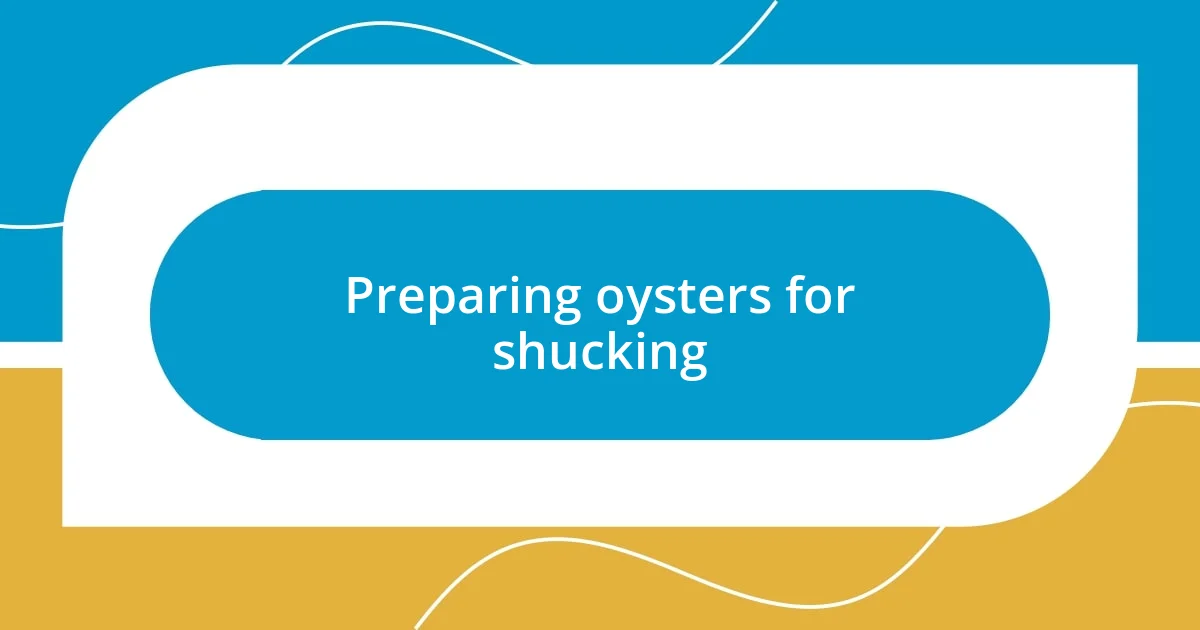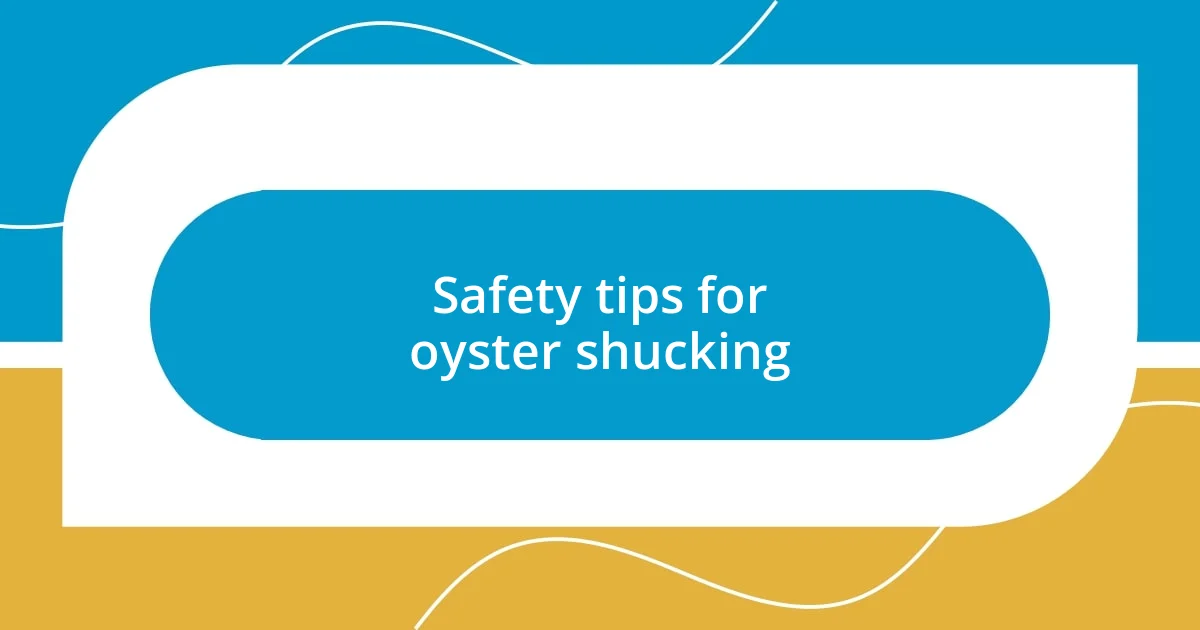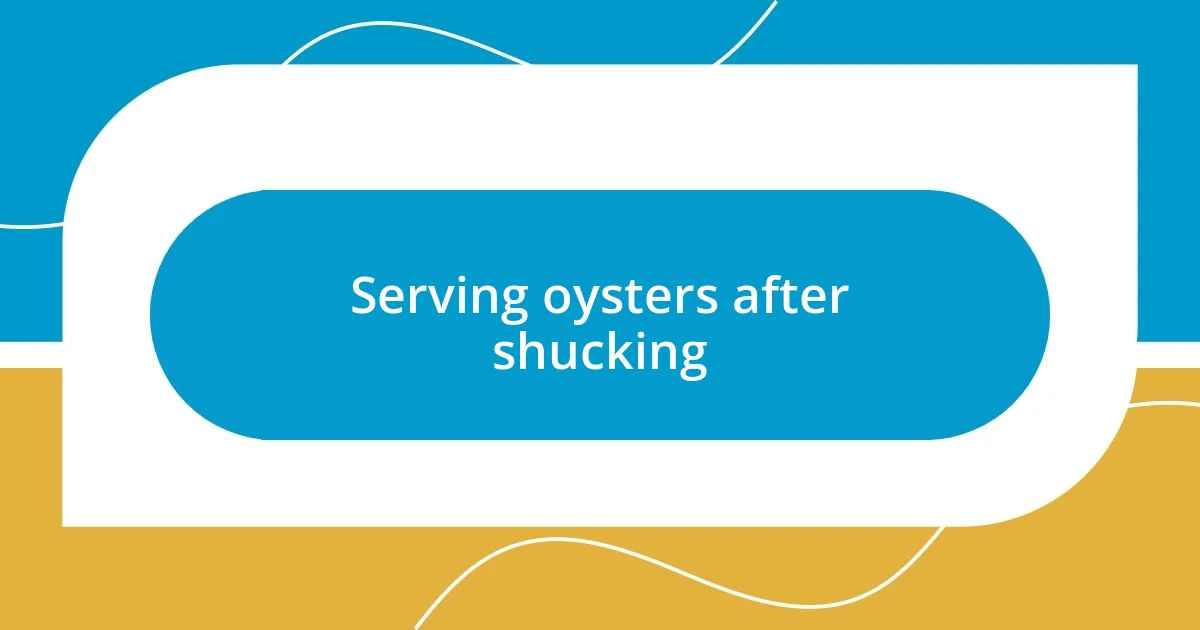Key takeaways:
- Essential tools for shucking oysters include a sturdy oyster knife, quality shucking gloves, and a stable shucking board for safety and efficiency.
- Choose fresh oysters by looking for tightly closed, heavy shells and considering seasonal varieties and local origins.
- Enhance the serving experience by presenting shucked oysters on crushed ice and adding garnishes like lemon wedges and mignonette sauce, along with cocktail forks for easy handling.

Understanding oyster shucking tools
When it comes to oyster shucking, the right tools can make all the difference. I’ve discovered that a sturdy oyster knife is essential; its short and thick blade allows you to pry open those tightly sealed shells with confidence. Have you ever struggled with a flimsy knife? I know I have, and it often ended in frustration, or worse, an accidentally punctured hand!
Beyond the knife, I can’t stress enough the importance of a quality shucking glove. It may sound trivial, but trust me—wearing a glove designed for oyster shucking has saved me from some close calls. Have you ever felt that rush of adrenaline when the knife slips? A good glove provides both protection and grip, ensuring you stay safe while enjoying the process.
Let’s not forget about a solid oyster shucking board. A stable surface is crucial for control, and I’ve learned this the hard way. I once tried shucking on a wobbly table, and let’s just say it turned into quite the chaotic experience! Choosing the right tools not only enhances your efficiency but also transforms the experience into something enjoyable and safe. So, what tools are you using, and how do they shape your oyster shucking adventures?

Choosing the right oysters
When it comes to choosing oysters, I’ve realized that not all varieties are created equal. I gravitate towards the ones that are tightly closed; they often signal freshness and quality. After a few disappointing shucking sessions, I learned to look for those that feel heavy for their size, which can indicate plump meat inside.
- Look for tightly closed shells.
- Choose heavier oysters for their size.
- Pay attention to the time of year; certain types taste better in specific seasons.
- Local varieties often yield fresher, tastier oysters.
- Consider the oyster’s origin; different regions offer unique flavors.
I remember a time diving into a batch of oysters that looked perfect but turned out to be mediocre in flavor. It taught me that even a seemingly good choice can disappoint. The thrill of selecting the right oysters and knowing I’m setting myself up for success is part of what makes shucking so rewarding. It’s like being on a treasure hunt—each oyster holds the potential for a delightful flavor experience!

Preparing oysters for shucking
When preparing oysters for shucking, the first step is to rinse them under cold running water. This washes away any grit and sand, ensuring a cleaner shucking experience. I can’t emphasize how satisfying it is to see each oyster gleaming after a good rinse; it sets the tone for what’s to come. If you’ve ever bitten into a gritty oyster, you know how that can ruin the moment.
Once rinsed, I like to check for any damaged or open shells. A healthy oyster should close its shell tightly when tapped. If it doesn’t, I know it’s safer to discard it. I remember the first time I popped open an oyster that didn’t react—it was an unsettling experience. It taught me an invaluable lesson about vigilance and respect for the seafood I’m working with.
Next, placing the oysters in a shallow bowl with ice is my go-to. It not only keeps them chilled but also helps maintain their texture, ensuring the best taste when I’m ready to indulge. Trust me, there’s nothing quite like shucking that fresh, chilled oyster—it feels like unearthing a hidden gem each time!
| Preparation Step | Description |
|---|---|
| Rinse the oysters | Wash under cold running water to remove grit and sand. |
| Inspect for damage | Tap shells to ensure they close tightly; discard those that don’t. |
| Chill on ice | Keep oysters in a shallow bowl of ice to maintain freshness. |

Techniques for opening oysters
When it comes to techniques for opening oysters, I’ve honed my method over time to make the process smoother and more enjoyable. Using a sturdy oyster knife is crucial; I learned the hard way that flimsy utensils just don’t cut it—pun intended! As I hold the oyster in one hand, I always make sure to cover the top shell with a kitchen towel for added grip and safety. Have you ever had that moment when the knife slips? Trust me, you don’t want to go there.
After positioning the oyster, I gently insert the knife tip into the hinge area. I remember the first time I missed the hinge and ended up fumbling around, which was both frustrating and comical. Now, I practice patience. I tap the knife gently to pry the shell open, feeling for that satisfying pop. Nothing compares to that moment when the shell gives way and you’re welcomed with the fresh brininess of the oyster inside. It’s almost like a mini celebration!
Lastly, I make it a point to run the knife along the inside of the top shell to release any muscle that might be holding on. There’s a sense of accomplishment that washes over me as I slide the knife along, imagining I’m a sculptor unveiling a masterpiece. When I finally lift that top shell away, I can’t help but admire the pristine oyster, just waiting to be enjoyed. It feels like each technique brings me closer not just to a delicious bite, but to an experience that connects me with the ocean!

Safety tips for oyster shucking
When shucking oysters, safety is paramount. I’ve learned that wearing protective gloves is a game-changer. The first time I went without them, I ended up with a nasty cut from a stubborn oyster shell. That moment not only stung physically but also served as a reminder of the risks involved. Trust me, a good pair of cut-resistant gloves can save you from a world of hurt.
Using a proper oyster knife is equally important. I remember when I tried to use a regular kitchen knife—what a disaster that was! The blade slipped, and I almost lost my grip on the oyster, leading to a chaotic scene in my kitchen. My advice is to invest in a solid, purpose-built oyster knife with a sturdy blade. Not only does it make the process easier, but it also makes shucking much safer overall.
Lastly, make sure you use a stable base when shucking. I learned this the hard way during my early shucking adventures. Balancing the oyster on a flimsy cutting board was a setup for disaster! Placing the oyster in a secure position, such as a folded towel or a specialized shucking platform, gives you the grip needed to work confidently. Think about it—wouldn’t you rather focus on enjoying the delicious oyster than worrying about accidents? Ensuring your workspace is secure can elevate the whole experience.

Serving oysters after shucking
Once you’ve shucked those oysters, serving them in style enhances the entire experience. I like to arrange them on a bed of crushed ice, which not only keeps the oysters chilled but also adds a touch of elegance to the presentation. There’s something gratifying about seeing those glossy shells glistening against the ice; it feels like a small tableau of oceanic beauty right on your table. Have you ever considered how much our surroundings influence the flavors we perceive?
I personally enjoy garnishing the oysters with fresh lemon wedges and a side of mignonette sauce. The bright citrus cuts through the richness, while the tangy sauce adds a layer of complexity. It’s almost like a dance of flavors in your mouth! I recall a gathering where I stirred up a bit of friendly competition among my friends to see who could discover the best topping combination. It became a memorable evening filled with laughs and delicious bites—a perfect reminder of the joy oysters bring to gatherings.
Don’t forget to incorporate a selection of cocktail forks or small utensils to enhance the dining experience. I’ve been at too many parties where guests awkwardly fumble trying to dig out the oysters with just their hands. Adding those little touches not only elevates the meal but also shows guests that you care about their comfort. It’s these small details that often leave a lasting impression—one that makes them look forward to the next oyster night at your place!














